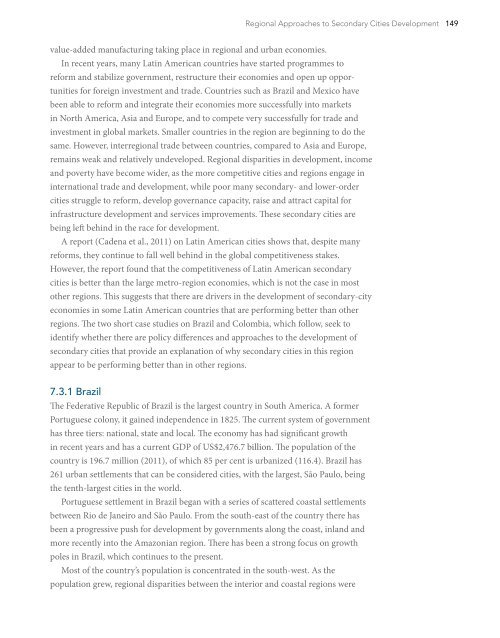DYhWN
DYhWN
DYhWN
You also want an ePaper? Increase the reach of your titles
YUMPU automatically turns print PDFs into web optimized ePapers that Google loves.
Regional Approaches to Secondary Cities Development 149value-added manufacturing taking place in regional and urban economies.In recent years, many Latin American countries have started programmes toreform and stabilize government, restructure their economies and open up opportunitiesfor foreign investment and trade. Countries such as Brazil and Mexico havebeen able to reform and integrate their economies more successfully into marketsin North America, Asia and Europe, and to compete very successfully for trade andinvestment in global markets. Smaller countries in the region are beginning to do thesame. However, interregional trade between countries, compared to Asia and Europe,remains weak and relatively undeveloped. Regional disparities in development, incomeand poverty have become wider, as the more competitive cities and regions engage ininternational trade and development, while poor many secondary- and lower-ordercities struggle to reform, develop governance capacity, raise and attract capital forinfrastructure development and services improvements. These secondary cities arebeing left behind in the race for development.A report (Cadena et al., 2011) on Latin American cities shows that, despite manyreforms, they continue to fall well behind in the global competitiveness stakes.However, the report found that the competitiveness of Latin American secondarycities is better than the large metro-region economies, which is not the case in mostother regions. This suggests that there are drivers in the development of secondary-cityeconomies in some Latin American countries that are performing better than otherregions. The two short case studies on Brazil and Colombia, which follow, seek toidentify whether there are policy differences and approaches to the development ofsecondary cities that provide an explanation of why secondary cities in this regionappear to be performing better than in other regions.7.3.1 BrazilThe Federative Republic of Brazil is the largest country in South America. A formerPortuguese colony, it gained independence in 1825. The current system of governmenthas three tiers: national, state and local. The economy has had significant growthin recent years and has a current GDP of US$2,476.7 billion. The population of thecountry is 196.7 million (2011), of which 85 per cent is urbanized (116.4). Brazil has261 urban settlements that can be considered cities, with the largest, São Paulo, beingthe tenth-largest cities in the world.Portuguese settlement in Brazil began with a series of scattered coastal settlementsbetween Rio de Janeiro and São Paulo. From the south-east of the country there hasbeen a progressive push for development by governments along the coast, inland andmore recently into the Amazonian region. There has been a strong focus on growthpoles in Brazil, which continues to the present.Most of the country’s population is concentrated in the south-west. As thepopulation grew, regional disparities between the interior and coastal regions were


